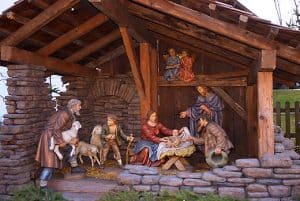by Steven Berringer
an article originally published by Always Ready Ministries
But when the set time had fully come, God sent his Son, born of a woman, born under the law, to redeem those under the law, that we might receive adoption to sonship.
Galatians 4:4-5 (NIV)
I love the Christmas season! Joyful feelings surround us all—even to such an extent that sometimes the stingiest person among us cracks a smile. (Yes, there is hope for that relative on whom you’d almost given up!) Shared times with family members and friends, delicious food, and gift exchanges—among many other wonderful things—set the stage for us to deepen our relationships with those we love. This atmosphere of Christmas “magic” is so uplifting! It even spills over into the subsequent transition to a new year one week later, when we look forward with hope to fresh opportunities that lie ahead.
Beyond this, and even more to the point of Christmas itself, Scripture readings and our involvement in worship and candlelight services remind us of the absolutely mind-blowing Christmas story.

An innocent, helpless baby boy was born on a cold and silent night in what today we might call a barn or stable, and His mother laid Him in a feeding trough! Yes, a feeding trough! Not long after, angels announce His birth to lowly shepherds working on a nearby hillside. Overjoyed, they leave their fields and race to the place of the baby’s birth to see Him with their own eyes! Eventually, the impact of this individual on the world truly would be beyond anyone’s ability to comprehend! The songs and music of Christmas (those works that focus on Him) only reinforce our awe and wonder as we reflect on the holynight Jesus was born.
Getting the Big Picture
As awe-inspiring as the story is, I can’t help but notice the stunning lack of context that permeates our thinking regarding the Christmas Story. Honing in on the events of one night, or even a few days, months or years gives us an unbalanced perspective.
Do not misunderstand. Obviously there is great value in focusing on the miracles occurring on and around Jesus’ birthday. I am not speaking against this, but I am contending we miss out on the fullest blessing of Christmas if we limit our study and reflection to Jesus’ birth and the events that surrounded it. We need to see His arrival against the backdrop of the wide stage of world history!
Think of the Marvel Cinematic Universe (MCU). When a new MCU movie comes out, fans will hop on YouTube and watch summary videos of the previous movies to understand the context of the new one. Sure, we could just walk into the theater and watch the newest MCU movie. Probably we would follow the story reasonably well. Yet, without an understanding of the larger context of the Universe, we would miss out on a great many nuances and details. These include all the different stories, references to related characters and themes, and flashbacks—all of which contribute to the overarching MCU saga.

A lack of understanding is one thing when it relates to a fictional story. It is quite another when it relates to the biblical account of Jesus’ entrance into the world—an actual event that was so important it split history in two. Let’s not jump into the narrative of Jesus’ birth and completely ignore how we got there! Context matters, especially with sacred truth! The context for the Christmas Story is what makes it the most wonderful story ever told. Here we’ll provide a very streamlined overview.
Let’s not jump into the narrative of Jesus’ birth and completely ignore how we got there!
Our Need for A Savior
We all know how the Bible begins: “In the beginning God created the heavens and the earth.” Why did God create at all? In his book Searching for God Knows What, speaker and author Donald Miller observes, “If God is a perfect and loving Being, the most selfless thing He could do would be to create other beings to enjoy Him.”1 As individuals who are extremely imperfect and frankly often irritating, we have a tough time understanding this concept. It’s a reality of creation nonetheless.
God created man to do purposeful work and to enjoy being in an intimate relationship with Him. Sadly, man decided that instead of knowing and following God, it would be better to be like Him—but not in a way that involved obedience. Genesis 3 reports the original fall of man, a fall from innocence that ushered sin and death into the world. Lured away by lies about God and His intentions—lies that came from Satan in the form of a serpent—Eve
saw that the tree [with the forbidden fruit] was good for food and delightful to look at, and that it was desirable for obtaining wisdom. So she took some of its fruit and ate it; she also gave some to her husband, who was with her, and he ate it. 7 Then the eyes of both of them were opened, and they knew they were naked; so they sewed fig leaves together and made coverings for themselves (Gen. 3:6-7).
Man’s sin defied God, disrupted both Adam’s and Eve’s fellowship with God, and incited divine wrath that had to be appeased. It appeared as if all hope was lost.

God, however, did not mark man a “failed experiment.” Instead He devised a plan to satisfy His wrath and to pave the way for forgiveness and the restoration of the lost relationship. He initiated it almost immediately, but it still would take centuries to implement. The Lord established a series of covenants at various points in history that would culminate in the arrival, life, death, burial, and resurrection of a “Man of God” who would rescue humanity from eternal death. A covenant is an “agreement between God and man in which God pledges to bless those who accept and commit themselves to him.”2
A covenant is an “agreement between God and man in which God pledges to bless those who accept and commit themselves to him.”
—Millard Erickson—
Covenant Faithfulness
The first of these covenants came immediately after the fall of man. God told the serpent, who was the embodiment of Satan, what the One-to-come would do to him:
I will put enmity between you and the woman, and between your offspring and hers; he will crush your head, and you will strike his heel” (Gen. 3:15, NIV).
It was the darkest day on earth up until that time, but God already was providing a reason for people to hope as He pointed to One who would come to defeat Satan. This is known as the Adamic Covenant.
The second covenant came many years after Adam and the original fall. It is known as the Noahtic Covenant. This covenant is found Genesis 9:8-17. After Noah’s Ark settled on dry ground following the Great Flood, God promised that He never again would destroy the earth with a flood, and He placed His rainbow in the sky as a symbol of that promise. Conventional wisdom contends that God surely had messed up by creating beings who incited His wrath through their disobedience, to a point He was compelled to destroy all but eight of them! This “wisdom” is wrong! God never messes up, but humanity did, repeatedly and in extreme ways. Against this backdrop we see God’s steady faithfulness, as well as His undying love for those He had created, despite their sin.
God would initiate additional covenants as well. We’ll consider at least three more next time.
Be sure to return.
Meanwhile, use this Bible-reading plan over the next week.
Blessings to you as you prepare your heart to celebrate Jesus’ birthday!
December 16, 2018
Access other articles published by Always Ready Ministries here.
Steven Berringer is the Student Pastor at The Bible Chapel at the Robinson Township near Pittsburgh, Pennsylvania.
Copyright © 2018 by Always Ready Ministries. All rights reserved.
Notes:
1Donald Miller, Searching for God Knows What, (Nashville: Thomas Nelson, 2004), 122.
2Millard J. Erickson, Concise Dictionary of Christian Theology, (Grand Rapids: Baker Book House, 1986), 38.
Unless otherwise noted, all Scripture quotations are taken from the Christian Standard Bible®, Copyright © 2017 by Holman Bible Publishers. Used by permission. Christian Standard Bible®, and CSB® are federally registered trademarks of Holman Bible Publishers.
The passages marked NIV come from The Holy Bible, New International Version®, NIV® Copyright © 1973, 1978, 1984, 2011 by Biblica, Inc.® Used by permission. All rights reserved worldwide.